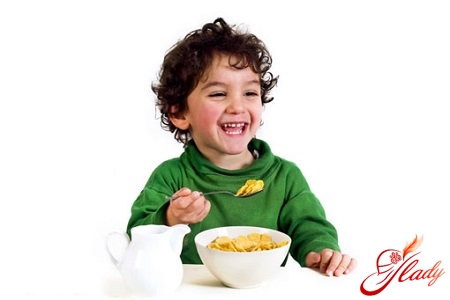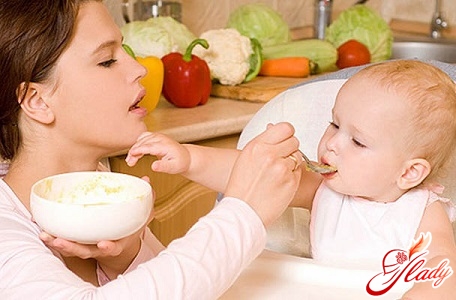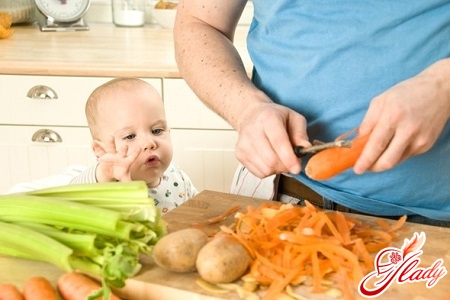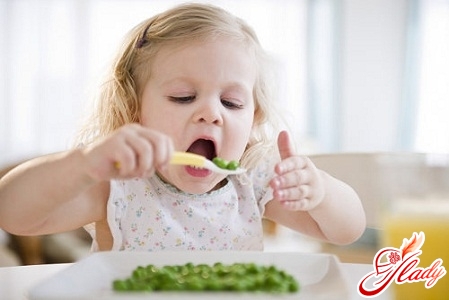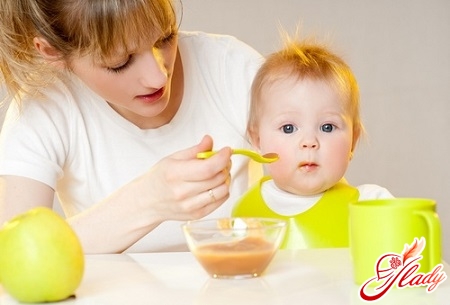
Here's your kid and turned one year - veryan important and exciting date that mom and dad, grandparents, aunts and uncles eagerly awaited. This first year flew very quickly - behind sleepless nights and excitement due to colic or first teeth, the joy of the first smile, the first word and the first step. Birthday with balloons, gifts, cake in the form of bears or hares will forever remain in memory and in photographs. Your baby has become so big, but to an adult he is still very far away. And the main task of the mother is to help your child grow up healthy, smart and strong. Harmonious development of the child - this is the correct organization of the regime of the day, and exciting activities, appropriate to age, and walking in the fresh air, and much more. But the most important thing is a full-fledged nutrition of a one-year-old child.

Products that must be part of the daily diet
Milk and dairy products In the year, many childrencontinue to be breastfed, receiving a lot of nutrients from the mother's milk. The World Health Organization (WHO) recommends that breastfeeding be continued until 1.5-2 years - this is appropriate and useful for both the health of the child and the health of the mother. If a year you continue to feed your baby and have the opportunity to preserve lactation, then mother's milk will continue to be an excellent source of protein and other nutrients. In addition, breast milk will protect the child from many infections. If your baby received an adapted milk formula, then the share of dairy products in his diet should not be sharply reduced. Milk and dairy products are a valuable source of protein, calcium, B vitamins. For a child who is one year old, the daily norm of dairy and sour milk products should be 500-600 ml. Preference should be given to specialized products suitable for feeding children older than 1 year. These are milk formulas, enriched with microelements and vitamins, baby kefir, and raw cheese. In addition, the diet must include cottage cheese, which can be given not only in its pure form. In the baby's menu, you can gradually start to enter casseroles from cottage cheese and vegetables or from cottage cheese and cereals. Dishes from cereals - porridge In the daily menu of the baby one must always have one of the porridges: buckwheat, rice, oatmeal, corn or some other. Porridges are very useful for digestion and contain valuable nutrients, trace elements and vitamins. Porridge is not brewed thick, cereals are first well boiled in water, and then brought to the ready for milk. Kashi can be cooked as sweet, adding a small amount of sugar, and unsweetened, then you can serve them as a side dish to meat. If you want to replace sugar with honey, then you need to do it very carefully, since this product is often allergic. Porridge is also a very satisfying dish, so give it to your child no more than once a day. And some cereals, for example, wheat and oats, contain phytic acid, which prevents the absorption of calcium, phosphorus, magnesium and other minerals from the digestive tract, thereby affecting the formation of bone tissue and the development of the whole organism. Therefore, the porridges that are present in the baby's food should be alternated, and so popular in previous years semolina porridge should be included in the menu quite rarely. Do not rush to introduce into the diet of a child and pasta, because their nutritional value is not very high. you will certainly know your crumb with this product when he becomes older, for example, to two years. Be sure to choose high-quality pasta of small varieties, made exclusively from durum wheat. Prepare them better in milk, adding a little butter in the finished dish. One year is the age at which it's time to introduce crumbs to one more product. It's about bread. It should start with white wheat bread, which is easier to digest by the body, and after a while it will be possible to gradually include in food and black rye bread. 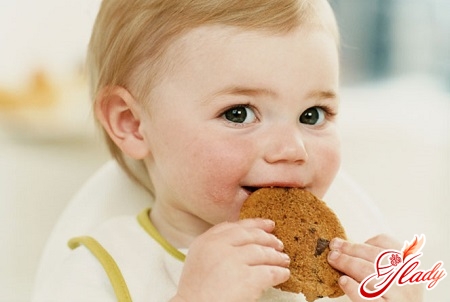 Vegetable dishes and fruit Introduction of your baby withvegetables occurred at the age of about six months - most moms begin the first lure with vegetables. During this time, the child had to try and learn the taste of a fairly large number of species of these, undoubtedly, useful products. Potatoes, white cabbage and cauliflower, beets, zucchini, carrots, onions, broccoli, pumpkin - all these vegetables should already be included in its diet. Vegetables in the baby's menu for up to a year were present in the form of grated soups, mashed potatoes or casseroles. After a year, you can gradually enter the food, which will be attended by unpeeled pieces, since many children already know how to chew well enough. If your crumbs with this still have problems, then continue to give him a well-ground meal, and offer a firm one from time to time. In summer, try to diversify the baby's nutrition with fresh vegetables and fruits. If there are difficulties with chewing food, then rub such products on a grater. Vegetables can be given in the form of salads, for example, from finely grated carrots, peeled cucumbers or tomatoes, you can add salads in small quantities to salads. Preference should be given to the fruits that grow in your area - these are apples, pears, plums and so on. To exotic fruits should be treated with great care because of the increased risk of allergic reactions. In winter it is necessary to include in the diet specialized baby food in cans from well-known manufacturers. And also to prepare soups and mashed potatoes, compotes and kissels from frozen fruits and vegetable mixes. Vegetable puree (daily norm of 200 g) is better to cook simultaneously from several components, from time to time alternating them. Ready-made soups or purees are added with vegetable or butter. Do not get carried away with mashed potatoes because of the high content of starch in it, which makes it difficult to digest food, because the daily norm is only 150 g. Protein food - meat, fish, eggs It is difficult to overestimate the importance of protein in children's nutrition - without it, the full development and growth of the body is impossible. Meat must be included in the ration of the baby at the age of 1 year, as it is a full-fledged source of not only protein, but also iron, and also vitamins of group B. The child can cook steamed meatballs or meatballs from beef or veal, rabbit, chicken and turkey meat - the norm of meat is 85 g. You can vary the food at the expense of by-products: liver, tongue or heart. In addition, you can feed your baby with special baby canned meat. Instead of meat 2-3 times a week in the menu of the child include low-fat varieties of fish, for example, fillets of pollock, cod or pike perch. Fish contains a large amount of phosphorus, which is necessary for the proper formation and growth of bone tissue. Sea fish contains iodine and polyunsaturated fatty acids. The fish is boiled or cooked for a couple, after which it must be carefully grinded. Eggs for children under the age of one and a half years are given only hard-boiled, and it is recommended to give only the yolk, adding it to vegetable purees. After reaching the age of 1.5 years the child can be fed with protein and yolk. The daily rate for this age is ½ part of the egg. Most likely, the kid will have to taste the egg, cooked in the form of a normal omelet or omelette with vegetable additives (green peas, cauliflower, carrots).
Vegetable dishes and fruit Introduction of your baby withvegetables occurred at the age of about six months - most moms begin the first lure with vegetables. During this time, the child had to try and learn the taste of a fairly large number of species of these, undoubtedly, useful products. Potatoes, white cabbage and cauliflower, beets, zucchini, carrots, onions, broccoli, pumpkin - all these vegetables should already be included in its diet. Vegetables in the baby's menu for up to a year were present in the form of grated soups, mashed potatoes or casseroles. After a year, you can gradually enter the food, which will be attended by unpeeled pieces, since many children already know how to chew well enough. If your crumbs with this still have problems, then continue to give him a well-ground meal, and offer a firm one from time to time. In summer, try to diversify the baby's nutrition with fresh vegetables and fruits. If there are difficulties with chewing food, then rub such products on a grater. Vegetables can be given in the form of salads, for example, from finely grated carrots, peeled cucumbers or tomatoes, you can add salads in small quantities to salads. Preference should be given to the fruits that grow in your area - these are apples, pears, plums and so on. To exotic fruits should be treated with great care because of the increased risk of allergic reactions. In winter it is necessary to include in the diet specialized baby food in cans from well-known manufacturers. And also to prepare soups and mashed potatoes, compotes and kissels from frozen fruits and vegetable mixes. Vegetable puree (daily norm of 200 g) is better to cook simultaneously from several components, from time to time alternating them. Ready-made soups or purees are added with vegetable or butter. Do not get carried away with mashed potatoes because of the high content of starch in it, which makes it difficult to digest food, because the daily norm is only 150 g. Protein food - meat, fish, eggs It is difficult to overestimate the importance of protein in children's nutrition - without it, the full development and growth of the body is impossible. Meat must be included in the ration of the baby at the age of 1 year, as it is a full-fledged source of not only protein, but also iron, and also vitamins of group B. The child can cook steamed meatballs or meatballs from beef or veal, rabbit, chicken and turkey meat - the norm of meat is 85 g. You can vary the food at the expense of by-products: liver, tongue or heart. In addition, you can feed your baby with special baby canned meat. Instead of meat 2-3 times a week in the menu of the child include low-fat varieties of fish, for example, fillets of pollock, cod or pike perch. Fish contains a large amount of phosphorus, which is necessary for the proper formation and growth of bone tissue. Sea fish contains iodine and polyunsaturated fatty acids. The fish is boiled or cooked for a couple, after which it must be carefully grinded. Eggs for children under the age of one and a half years are given only hard-boiled, and it is recommended to give only the yolk, adding it to vegetable purees. After reaching the age of 1.5 years the child can be fed with protein and yolk. The daily rate for this age is ½ part of the egg. Most likely, the kid will have to taste the egg, cooked in the form of a normal omelet or omelette with vegetable additives (green peas, cauliflower, carrots).
Sample menu for the day
The stomach volume of a child in one year is still small,so he should eat often, but in small portions. The number of meals should be five. The daily intake rate is 1200 g, therefore, one meal is 240 g, the interval between feedings is about 3.5-4 hours.
- The first breakfast is breast milk or milk formula.
- Breakfast - porridge, which contains a large supply of energy substances needed to charge vivacity for a whole day.
- Lunch - meat or fish dish with vegetablegarnish, or soup, cooked on meat broth (the first water after boiling broth you need to drain, then pour the meat again with fresh water and cook until done).
- Snack - fruit puree or juice.
- Dinner - vegetable puree, and before going to bed breast milk or kefir.
For the first year your baby has achieved a lot fromfeeding exclusively breast milk passed to a variety and almost adult food. But do not rush it. Introduce new foods and dishes into your baby's diet very gently and gradually, observing the body's reaction. Prepare food, taking into account the features of the digestive system and the chewing apparatus of the baby. The child's diet should be diverse and full, that is, include all the necessary nutrients, trace elements and vitamins. And, of course, for cooking, you need to use only the highest quality and fresh products.




